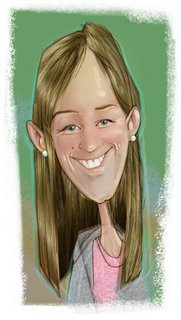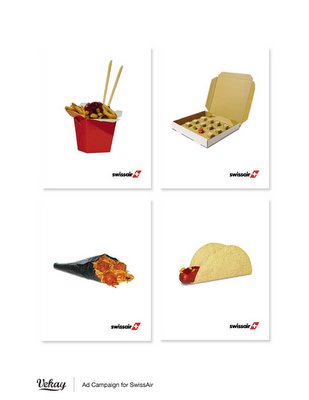
Graphic design is my life. I live and breathe it, and there's nothing more exciting to me than design, creativity, and idea generation. I am currently coauthoring a book called "W!RED: Caffeine for the Creative Mind" for HOW Books. This book is a collection of exercises that can be used to stretch your creative mind and aid in daily creative maintenance. The book also includes interviews with designers such as Margo Chase, Jeff Fisher, Steve Morris, John Foster, John and Sheree Clark of Sayles Graphic Design, Ingo J. Ramin, Kevin Carroll, and many others. In addition to the book, my coauthor (Stefan Mumaw) and I will be speaking at the HOW Design Conference next year in Las Vegas.
When did you first decide to become a graphic designer/illustrator? Was there a pivotal moment?
From the time I was born I was into “artsy” stuff. My first masterpiece was created at age 2 with Vaseline and my parents’ brand new sofa. At 16 I attended an international school in
Am I allowed to say everything? That’s such a lame answer, I know, but it’s true! I love learning. I think that’s an important attribute of a designer. With new clients that could range from The National Aardvark Society to NASA, designers have to be able to learn everything they can about who their client is so that they can convey the client’s message effectively. You have to live and breathe your client.
From a purely inspirational standpoint, I love books. There’s nothing more appealing to me than spending an entire Saturday in a Borders bookstore in the design section marveling at all of the books and sipping an iced coffee. My favorite “reads” would be books containing patterns and textiles (many of these books can be found in Borders and Barnes and Nobles), and design magazines such as HOW and Lurzer’s International Archive.
I love paper samples. I love meeting other designers and finding out what makes them tick. I love traveling and exploring different cultures. Music and music video watching are a recent hobby of mine (music videos have become so much more “creative”), as well as intros to movies. I love seeing the title sequences of movies – it shows how design is now being more integrated in other mediums such as film, PDA graphics, iPods, etc.
Where does your training come from? Self-taught? College/Art School?
Most of my design training came from
How do you keep “fresh” within your industry?
I’m always reading – the news, design magazines, designers’ posts in design forums on the Internet. I love finding random things online, or a new wacky store, and just exploring it. Sometimes these unusual places or things may later inspire an idea or a thought that will solve a design problem for a project. Sometimes it won’t. Regardless of what happens, you will always be learning and accumulating knowledge, and in my opinion that’s the most important and powerful tool that anyone can have.
What are some of your current projects?
A new identity project for The Heart Gallery of Orange County which included a re-design of their logo and website.
A new website for Trader Joes.
A book that I’m coauthoring and designing for HOW Books called
“W!RED: Caffeine for the Creative Mind”.
Which of your projects are you the most proud of? And why?
I’m really proud of a Swissair campaign that I did in my senior year of design school. I wanted to communicate the idea that travel today is so common and enables more mobility and allows the average joe schmoe the opportunity to experience other cultures. I wanted to reflect that increased mobility with the merging of different cultures’ foods.
(See attached .jpg of artwork)
Are there any areas, techniques, mediums, projects in your field that you have yet to try?
I haven’t experienced very many packaging projects, and that’s something that I would love to take a stab at. It would be lovely to work on something three dimensional and tangible, and that people can interact with on a tactile level.
Any advice to the novice designer/illustrator?
Do what you love. If you truly love design, just do it. Don’t worry about money or let it rule your decisions. I occasionally do projects pro-bono just because I know that it would be a great design piece and that it will make me feel good. The paying work will eventually find you. Most of my big clients now came from small pro-bono projects that I did. You never know what might happen. I would also focus on self-promotion. It’s one of the most important things a designer can do to get their name out there and familiarize others about you. The more they see or hear your name, the more they will subconsciously have that name engraved in their mind for a future design project. Jeff Fisher of Jeff Fisher LogoMotives is one of the few designers who actually understands this important aspect of design. My last piece of advice would be to always be friendly, kind and courteous to people no matter who they are. You never know when you might meet that person again and what opportunities might arise from your relationship.
What makes a designed piece or illustration successful?
Success is a relative term. Success to me (a designer) means that the piece effectively communicates the client’s message, is balanced well, looks good, and the client is happy with it. But very rarely does the finished piece actually turn out the way you want it to. Clients often change things, and although you don’t agree with them there comes a point where you just have to do what they say. They are, after all, the ones that are paying you. As a designer, my job is to bring my expertise into the piece (as far as composition, suggestions, ideas, etc), but in the end if the client wants the ad to be neon green, I have to make it neon green (or at least fight like hell against it, and then settle for something in between).
What do you do to keep yourself motivated and avoid burn-out?
I pick up my book, W!RED, get away from the computer, and do some of the exercises. I get away from the computer - I won’t even check my email. I usually go hiking, or head to Borders (with my iced coffee), or watch a movie. I pretty much just participate in life and absorb everything I can. I spend so much time in front of the computer that it is actually refreshing to do something else – even if that something else is washing my car. To me I think the weekend is very important for a designer. It’s a time for your conscious mind to switch off and for your subconscious mind to turn on. I believe that this is of utmost importance for the following week or for a project that you need that “big idea” for.
What is the best thing on prime time TV right now?
Medium, Celebrity Poker, and Survivor!
Related Links:
W!RED: Caffeine for the Creative Mind
Vekay Creative
Recent Work:




0 comments:
Post a Comment